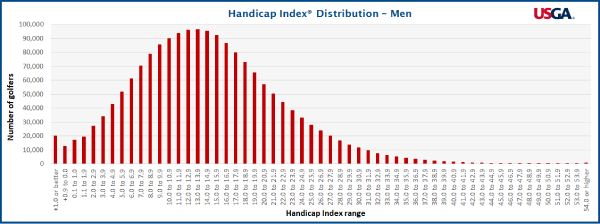
Golf is one of the most rewarding — and humbling — games in the world. While it’s easy to get caught up in equipment and swing techniques, understanding what is a handicap in golf is essential if you want to track your progress and compete fairly with other players. In this guide, we’ll break it down step by step.

Content
What Does Handicap Mean in Golf Scoring?
Let’s start with the basics: what does handicap in golf mean in golf scoring?
A golf handicap is a number that represents a golfer’s potential ability. It’s used to level the playing field between players of different skill levels, allowing them to compete more fairly. The lower your handicap, the better your potential to shoot low scores.
For example, a golfer with a handicap of 10 is expected to shoot 10 strokes over par on an average round. If you’re new to the game and shooting over 100, your handicap might be around 28–36.
Why the Handicap System Exists
The golf handicap system is all about fairness. Golf is unique in that it allows players of all abilities to play against one another — and still have a fair match — thanks to this system.
It adjusts scores based on each player’s skill level, which is calculated through recent scores, course difficulty, and slope ratings. This gives newcomers a way to improve and measure themselves over time.
How Does the Golf Handicap System Work?

So, how does handicap in golf system work exactly?
It relies on three major factors:
- Adjusted Gross Scores (your score minus any max score limits)
- Course Rating (the difficulty for a scratch golfer)
- Slope Rating (difficulty for a bogey golfer)
Your official handicap index is the average of the best 8 of your last 20 differentials, multiplied by 0.96.
Don’t worry — you don’t have to calculate this manually. Most golf apps or clubs can do it for you!
How Is a Golf Handicap Calculated?
Let’s dive deeper into how a golf handicap is calculated.
Step-by-Step Breakdown:
- Post Scores: Play 18 holes and record your adjusted gross score.
- Get Course & Slope Ratings: These are provided on your scorecard or club’s website.
- Apply the Formula: Use the calculation to get a handicap differential.
- Repeat: Do this for 20 rounds and average the best 8 differentials.
Once you have a few rounds in, your handicap index starts to reflect your playing potential. This number updates as you log more rounds.
What Is a Good Handicap for a Beginner Golfer?
Wondering what is a good handicap for a beginner golfer?
If you’re just getting started, don’t be alarmed if your handicap is in the high 20s or 30s. That’s completely normal. Many beginners start around 28–36 for men and 36–40 for women.
As you play more and improve your swing, your scores — and therefore your handicap — will drop. The key is consistency, not perfection.
Pro tip: A beginner with a handicap under 20 is doing exceptionally well.
What Is the Maximum Golf Handicap?

The USGA caps handicaps to maintain fairness in competition.
- For men: Maximum is 54.0
- For women: Maximum is 54.0
So, what is the maximum golf handicap you can have? It’s 54.0 regardless of gender, according to the World Handicap System.
This wide range accommodates beginners while still giving them a benchmark to strive toward. You don’t have to be a pro to track your improvement.
How to Establish a Golf Handicap
Ready to set up your first handicap? Here’s how to establish a golf handicap:
- Join a Club or Golf Association: Most require this to track handicaps.
- Play and Record Scores: You’ll need at least 3 18-hole scores or 6 9-hole scores to get started.
- Submit Scores: You can do this via a score posting kiosk at the course or through an app like GHIN or TheGrint.
- Receive Your Handicap Index: Once submitted, your handicap index will be calculated and updated as you play more.
Some digital scorecards and golf watch apps even make it easier to submit scores right from your phone.
Common Handicap Categories
Handicaps generally fall into these unofficial categories:
| Handicap Range | Skill Level |
| 0 – 5 | Advanced / Scratch |
| 6 – 12 | Intermediate |
| 13 – 20 | Recreational |
| 21 – 28+ | Beginner |
These ranges give you a general idea of where you stand and what goals to aim for.
Tips for Lowering Your Handicap
Want to lower your handicap? Here’s how:
- Track Every Round: Use a scoring app to monitor your stats.
- Focus on Short Game: Putting and chipping often make or break your score.
- Play Courses Strategically: Learn when to be aggressive or conservative.
- Take Lessons: Even a few sessions with a coach can dramatically improve your swing.
Improving your golf handicap is a rewarding part of your journey in the sport.
Conclusion
Understanding what is a handicap in golf is one of the most important steps in becoming a more serious player. It helps you track progress, play in tournaments, and compete fairly with others — regardless of skill level.
Whether you’re curious about how does the golf handicap system work or you’re ready to dive into how is a golf handicap calculated, the key takeaway is this: your handicap is your golfing fingerprint. It’s personal, it evolves, and it shows your potential.
Start by logging scores, learn how to apply the handicap formula, and watch as you get better over time. You don’t have to be a pro to enjoy the game — just get out there and play. Curious about equipment rules? Learn how much a golf ball weighs in our detailed guide.
FAQs About Handicap in Golf
How often should I update my golf handicap?
Your golf handicap should update every time you submit a new score. Most handicap systems recalculate your index daily based on the latest score data.
Can I have a golf handicap if I only play recreationally?
Yes! As long as you record your scores and have a valid course rating and slope, you can establish a handicap — even if you’re not playing in tournaments.

Eldon Barrett’s knowledge of sports is boundless. His in-depth analysis and captivating storytelling will make you see the games you love in a whole new light.



